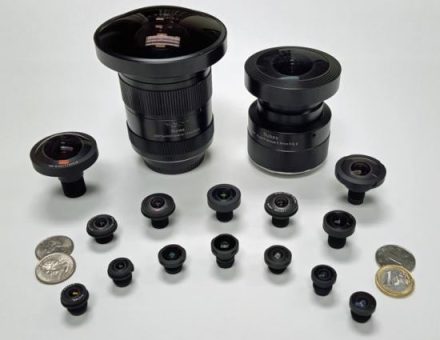Sunex has many online tools designed to help you find a lens according to your specifications that is best suited to your application. Once a lens is identified based on first order parameters, there can be many options or variants of that part number (PN). It is therefore useful to know how to interpret Sunex part numbers and the PN itself can provide insight into the lens’ performance or intended use. The intention of this article is to explain how our part numbers are structured and what the different variations indicate in order to help you fine-tune your choice of lens, options and configuration.
Sunex part numbers are structured in the following way:
DSLXXX[version letter]- [filter cut off]- F/#- [options, if any]
For example purposes, the lens DSL947A-700-F1.6 will be used for reference.
DSLXXX[version letter]- [filter cut off]- F/#
DSL947A-700-F1.6
- We will start with DSLXXX as highlighted above. This portion of the full part number refers to the lens assembly and the optical design itself. All part numbers with the same “DSLXXX” will have the same optical stack and thus same first order parameters. Using our example for reference, all lenses starting with DSL947 share the same optical design. This is called the base lens PN. All other alpha-numeric identifiers after DSLXXX are variants of this same optical design.
DSLXXX[version letter]– [filter cut off]- F/#
DSL947A-700-F1.6
- The letter after the DSLXXX indicates a mechanical “variation” of the lens assembly, and represents a modification that is independent of the lens optical design. Typically, this modification indicates a minor mechanical difference. For example, DSL947A-700-F1.6 has an M8x0.5 threaded barrel, while DSL947B-700-F1.6 has an M12 x0.5 threaded barrel. The difference in letter versions in this case is due to the thread of the barrel. Please take note that a specific letter itself is not unique to a particular change (e.g. not all “A” PNs are M8x0.5 thread), and the difference has to be noted by evaluating the drawing. It’s also important to note that these different “letters” are not REVISIONS. A revision, as in “rev B” is an engineering change to a PN which renders the previous revision obsolete and is not part of the Product PN itself.
- Possible differences can be inferred from the description and/or drawing. Some possible mechanical modifications that would require a different letter version:
- Barrel thread
- Flange/ threaded version
- Specific barrel differences (length of barrel, unique features, DMC code, etc)
DSLXXX[version letter]- [filter cut off]– F/#
DSL947A-700-F1.6
- The filter cut off indicates whether the lens assembly includes an IR cut-off filter and at what wavelength. The filter can be coated on one of the lens elements of the assembly, or could be included as a separate coated flat glass (if relevant for your application, contact Sunex to determine where the filter is located within an assembly). Examples of some of our filters can be found online.
- Some possible filter designations include:
- -NIR: no IR-cut filter/ absence of a cut-off filter
- -650: 50%T IR cut-off at 650nm (visible transmits)
- -700: 50%T IR cut-off at 650nm (visible transmits)
- -BP850: bandpass with T50% @850nm (visible light blocked)
- -BP940 bandpass with T50% @940nm (visible light blocked, IR transmission peak)
- -IRC40/41: dual bandpass filter (visible transmits, IR transmission peak); width of IR transmission peak varies with different IRC designations
- For detailed specifications, please refer to the specific part number drawing. Please contact Sunex if you are interested in custom filter options.
DSLXXX[version letter]- [filter cut off]- F/#
DSL947A-700-F1.6
- The final standard designation in the part number is the f-number (f/#). By definition, the f-number of an optical system is the ratio of the effective focal length to the diameter of the entrance pupil. A low f/# indicates a larger aperture, and a high f/# indicates a small aperture (f/1.6 has a much greater aperture and lets in more light than f/8). All optical designs are designed for a particular F/# depending on the initially intended application of the lens. Lenses can be modified to increase the f/# relatively easily; you may notice that Sunex already has some lenses with different apertures for the same lens. However, it is much more difficult and sometimes impossible to decrease the f/# (open the aperture) beyond the nominal design f/#.
DSLXXX[version letter]- [filter cut off]- F/#-[Options]
DSL947A-700-1.6-HP3
- Finally, there is one more optional appendix. If any alpha-numerical characters appear after the standard PN, this typically represents a special add-on, or possibly a customization option which is outside of our standard offering. There are several possibilities for this, but the most common are HP3 hydrophobic coatings, special identifiers, or custom binning options to name a few.
Many of the lens part numbers listed online are considered “standard,” but as can be seen throughout Sunex’s lens catalog, many modifications can be done to a particular lens assembly such as modifying the barrel mechanics, changing the filter, or changing the f/#. Changing the base PN (DSLXXX) indicates changing the first order optical parameters and represents an entirely new lens assembly and thus a new lens part number. For more information about the various lenses offered and modification options, please refer to this article or contact Sunex to discuss whether it would be beneficial to modify an existing lens, or proceed with a custom design altogether.

